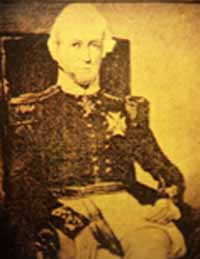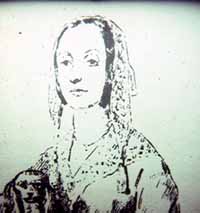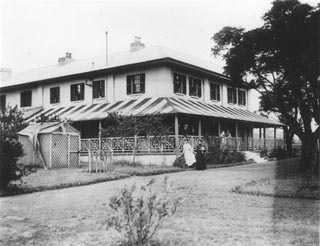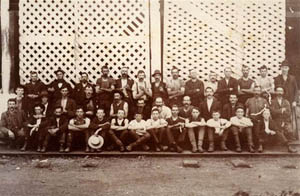The indigenous people of the Riverstone District were the Dharug aboriginal tribe. Their tribal lands extended from the Blue Mountains to the coastal area of eastern NSW. Those living in the Riverstone area were known as the South Creek tribe.
1790-1810
In April 1791 Governor Arthur Phillip led a party of 21 on an overland trek from Parramatta to the Hawkesbury for the purpose of exploring Richmond Hill (now Belmont, North Richmond). Others in the party included Captain Collins and his personal servant, Captain Tench, Lieutenant Dawes, Surgeon White, two sergeants, eight Marine privates, two aborigines, Colebee and Boladeree, and three convicts, chosen for their skilled marksmanship. The three convicts were the only armed members of the party! Failing to reach their objective the party set out to return to Parramatta via Prospect Hill. Their course took them across land that would one day be within Riverstone’s boundaries. Phillip described the land as “…poor soil but finely formed and covered with the stately white gum tree”.

By 1794 the Old Windsor Road from Parramatta to the Hawkesbury was winding its way through the area. In 1803 Governor King established a Government Stock Farm. Present day Riverstone was located in the northwest corner. On the night of March 4th 1804 convicts in the Castle Hill prison rose in rebellion with cries of “Death or Liberty!” This was Australia’s only armed convict uprising and the first military engagement in the colony. It became known as “The Battle of Vinegar Hill”. Convicts trying to make their escape to the Hawkesbury would have traversed the lands of the Riverstone district.
1810-1820
On 8th May 1810 Mary Putland, widowed daughter of deposed Governor Bligh, married Lieutenant Governor Maurice Charles O’Connell, the Lieutenant-Colonel in charge of the 73rd Regiment which had arrived with Governor Lachlan Macquarie to replace the NSW Corps (better known as the Rum Corps). On the eve of the marriage Governor Macquarie granted O’Connell 2500 acres of the land that is now Riverstone. The grant was all the land now bounded by the Windsor Road, Bandon Road Vineyard, Eastern Creek and Kensington Park Road Schofields. O’Connell named the land “Riverston Farm” after his birthplace in Ireland.

Whilst the O’Connells did not live at ‘Riverston’, Governor Macquarie noted in his diary that on 8th December “…Mrs M and myself set out in the carriage from Windsor to Parramatta. …we halted .. at Lt. Col. O’Connell’s farm at Riverston.” The ‘Riverston Farm’ homestead was located close to the Windsor Road. The only remaining relic from the farm is the bell used to call the convicts in from the fields, which we believe was given to St. Paul’s Church of England by John Schofield.
In 1813 Walter Lang was granted 700 acres on South Creek. He named the property “Clydesdale” (now in the Berkshire Park end of Marsden Park). In 1815 Reverend Samuel Marsden was granted 1,000 acres, now Marsden Park. Marsden ran sheep on this land. The following year Richard Rouse received 450 acres at Vinegar Hill and, with John Palmer’s 1818 grant of 1,500 acres, this area later became known as Rouse Hill. Rouse Hill House was completed in this year. In 1819 James Ruse was granted 100 acres of land on Eastern Creek.
1820-1860
In 1824 Charles Tompson, who had arrived as a convict in 1804, was the owner of Clydesdale. He purchased a further 1,000 acres and erected the home, known as “Clydesdale”, which still stands there. Charles Tompson gave land for St. Phillip’s Church of England, which was consecrated in 1846. St. Phillip’s was situated on flood prone land opposite Clydesdale on the northern side of Richmond Road. After 1889/90 it was allowed to fall into disrepair.

John Schofield arrived, as a convict, in 1821. Four years later he was granted a ticket of leave. In 1845 he purchased a 600-acre property, known as Argown, from Robert Fop, giving his name to the present day Schofields. Also, in 1845, ‘Riverston Farm’, comprising 3,500 acres, was offered for sale. Sir Maurice Charles O’Connell was appointed Acting Governor of NSW in 1846. He died in 1848 and was buried at Rookwood Cemetery. Ten years later Riverstone Estate was subdivided into 59 farm lots and again offered for sale.
1860-1880
Christ Church Rouse Hill, built on Windsor Road land donated by Robert Fitzgerald, husband of Elizabeth, youngest daughter of Richard Rouse, was opened in 1863. It was consecrated in 1878 and still stands. Today a modern church has been built behind it and the original church has become a children’s activity area. The cemetery behind the church, in Mile End Road, contains the graves of many of the pioneers of the area.
The Blacktown to Richmond railway line was completed towards the end of 1864 and the first regular train ran on 1st December 1864. In the early 1880s the main railway station building (the only original railway building on the Richmond Line still standing) was constructed. The railway’s timetable officially gave ‘Riverston’ the name ‘Riverstone’. In 1867 the greatest flood on record in the Hawkesbury area rose to a height of 19.2 metres.
The district’s earliest non-private school, the Nelson Denominational School, opened in 1866 on Old Pitt Town Road with a schoolhouse and teacher’s residence on ¾ of an acre purchased by Samuel Mason from Samuel Terry. It became a Public School in 1883. In 1891 a new school was built, on Nelson Road near Mark Road. Falling numbers saw this school closed in 1902 with the students transferred to Rouse Hill Public School. Maraylya (known as North Rocks) operated a Provisional School from 1868 till 1871. It reopened in 1874 and became a Public School in 1880. Its name was changed to Forrester in 1895 and became known as Maraylya in 1920. Vineyard opened a Provisional school in 1872. It became a Public School in 1880. Rouse Hill Public School opened in 1875.

A Post Office, with Stationmaster Mr. C. Burge in charge, was established at Riverstone Railway Station in 1877. In 1878 Benjamin Richards, a grazier and butcher from Richmond, purchased land adjacent to the railway line and established a beef slaughterhouse employing four slaughtermen, the beginning of the Riverstone Meatworks. The Meatworks was to expand greatly and become the chief employer for the Riverstone District till it closed in 1994.
1880-1890
Riverstone Estate was again offered for sale in 1881. St. John’s Catholic Church opened in 1882. The present brick building, on the same Garfield Road site, was opened in 1904. 1883 saw 42 children enrolled for the opening of Riverstone Public School. The first teacher was William Langton. William, his wife Mary and their six children, lived in the adjacent 2-roomed teacher’s residence. By the end of 1883 there were 72 students enrolled for the one roomed, one teacher school. Marsden Park Public School opened in 1889 and Oakville in 1900. In 1884 the main railway station building was constructed. This is the only original railway building on the Richmond Line still standing. In the same year St. Andrew’s Presbyterian Church opened in Regent Street. It was moved to its present site, in Garfield Road, in 1912. Today it is used by the St. Andrew’s Uniting Church as a supplement to their modern building on the same site. From 1875 to 1884 Presbyterian services were held in the Greig family in Garfield Road. This house still stands opposite the Lions Park and is used as a garden storage area by the owners. St. Andrew’s Church of England, The Vineyard also opened on Windsor Road in 1884. It was erected by voluntary labour and was also known at the Vineyard Mission School.
The first Anglican Church Service in Riverstone was held in the open air around a tree stump in Garfield Road. St. Paul’s Church of England opened in 1885 as part of the Parish of Windsor. It became a Provisional Parish in 1928 and a full Parish in 1930, incorporating Riverstone, Rouse Hill, Quakers Hill, Marsden Park, Schofields and The Vineyard. A Telegraph Station opened at the Railway Station in 1886 and Marsden Park Public School opened in 1889.
1890-1920
The first resident Policeman appointed to Riverstone, in 1892, was Mr. E. Grace. He moved in to the newly built Police residence, which is now used as Riverstone Police Station. The small original Riverstone Police Station is now at the closed Australiana Village at Wilberforce, as are a number of other buildings from the Riverstone District, amongst them the Marsden Park Public School, the Mangold family slab home and Riverstone’s Blair’s Fruit Shop. It was also in 1892 that a plague of phylloxera insects wiped out grape crops at The Vineyards.
The two churches at Marsden Park, which faced each other on the corner of Grange Avenue and Richmond Road, St. Andrew’s Presbyterian Church on the eastern corner (now being renovated to become tearooms) and St. John’s Church of England on the western corner (now a Plant Nursery) opened in 1898 and 1909 respectively.
Riverstone’s population in 1911 was 981. In 1914 a telephone exchange was installed at the Railway Station. To commemorate the many men from the Riverstone District who lost their lives in World War I, the War Memorial was unveiled in 1919. Schofields Public School opened in 1919. In 1920 the Olympia Theatre opened in Garfield Road (It closed in 1971). Prior to this movies were screened at the Oddfellows Hall (opposite the present Uncle Arthur’s Store) and the Temperance Hall (next to the Police Station in Railway Terrace).
1920-1940
Bill Nichols opened Riverstone’s first motor repair shop in 1926 in Garfield Road opposite the present Post Office. The following year he moved to the corner of Garfield Road and Carlton Street. In 1935 he moved to the site of the present Commonwealth Bank and, in 1962, to the site of the present Seven/Eleven Service Station. The Nichols family sold the business in 1986.
Until 1928 Riverstone was part of Windsor Shire Council. Dissatisfied with Windsor Council’s ability to provide the district with electricity and water, the residents voted to come under the administration of Blacktown Shire. Riverstone was connected to the Metropolitan Water Supply in 1933 and electrical services in 1934. Riverstone celebrated with the “Back to Riverstone” carnival.
1940-1970
A Methodist Church opened in Pitt Street in 1941. In 1943 a newly built Post Office building replaced the original post office, which had operated at the railway station since 1877. A Catholic School operated at St. John’s Catholic Church in 1950 and in 1955 St. John’s Primary School opened. In 1957 Riverstone Public School, which had moved from its original site to the corner of Garfield and Piccadilly Streets in 1929, moved its Primary Department to a new building in Elizabeth Street, leaving the Infants’ Department at Garfield Road. The Infants Department and the Pre-School opposite, which had opened in 1977, were consolidated with the Primary Department on the Elizabeth Street site in 2002.
In 1961 60 families were evacuated in what was to be Riverstone’s worst flood of the 20th century with floodwaters crossing the railway line at the railway gates. Evacuated families were taken in by other locals and furniture was stored in the RSL Club. In the 1978 flood families and furniture were housed in the High School Auditorium as Riverstone High School had opened in 1962. Riverstone’s first swimming pool was also opened in 1962. It was constructed using community raised funds and is the medium-sized pool in use today.
1970-2010
The 1970s brought many changes. A new complex at the Meatworks opened in December 1973. In May 1975 the rail line was electrified. Blacktown City Council opened the Riverstone Olympic Swimming Pool in 1976 and Riverstone Marketown and the Riverstone Branch Library in 1978.
In 1980 the Baptist Church, which had opened in 1966 on the corner of Regent and Oxford Streets, began to operate Coverdale Christian School on its premises. This school moved, with the church, to its present 5-acre site on the corner of McCulloch and Regent Streets in late 1984 and is now known as Norwest Christian College.
Two highly successful O’Connell County Fairs were organised by the Riverstone and District Historical Society in 1981 and 1983. The Sam Lane Community Complex opened in 1982. The 1983 Fair was held in conjunction with the centenary celebrations of Riverstone Public School. Monies raised from these Fairs, with a 1988 Bicentennial Grant, saw the Blacktown and District Bicentennial Museum (now known as the Riverstone Museum) open in the original public school premises in December 1988.
In 1996 Riverstone’s population was 5,497. In 2000 an initiative of the Combined Churches of Riverstone with the support of the Chamber of Commerce saw the inaugural Riverstone Festival held on the third Saturday in May. This had been planned as a “one-off” Awakening 2000 Project. It proved to be so highly successful that its small, willing committee has kept it running annually, promoting it as a celebration of “the best little country town in Sydney”. In 2002 Riverstone Public School consolidated on to one site in Elizabeth Street, the Garfield Road site became Casuarina School and a Childcare Facility replaced the Pre-School. In 2009 a Community Hall was added to the Sam Lane Complex.
As the district enters a new decade many changes are foreboding. It will rest with the residents to maintain the community spirit that has typified “Rivo”.
